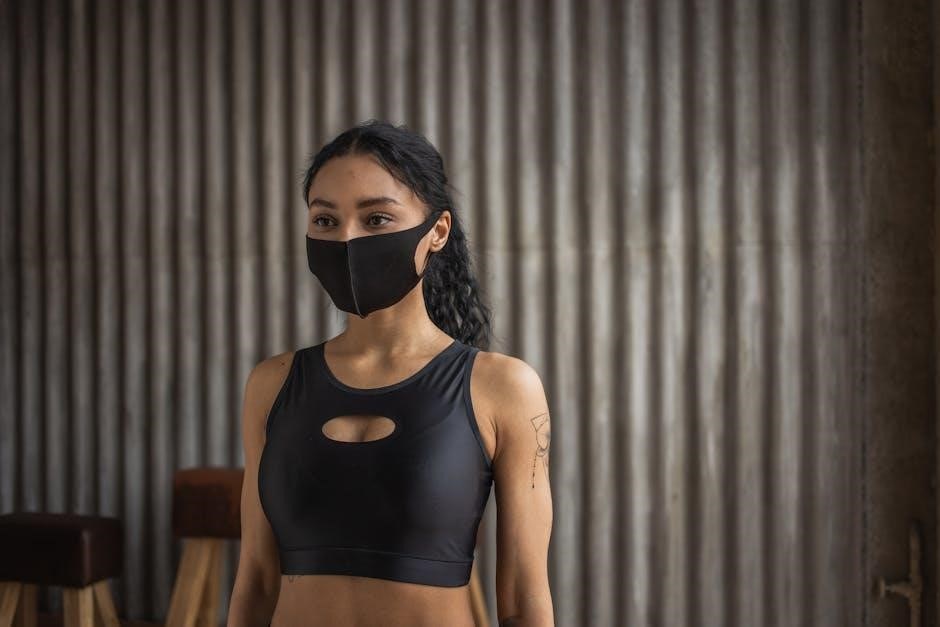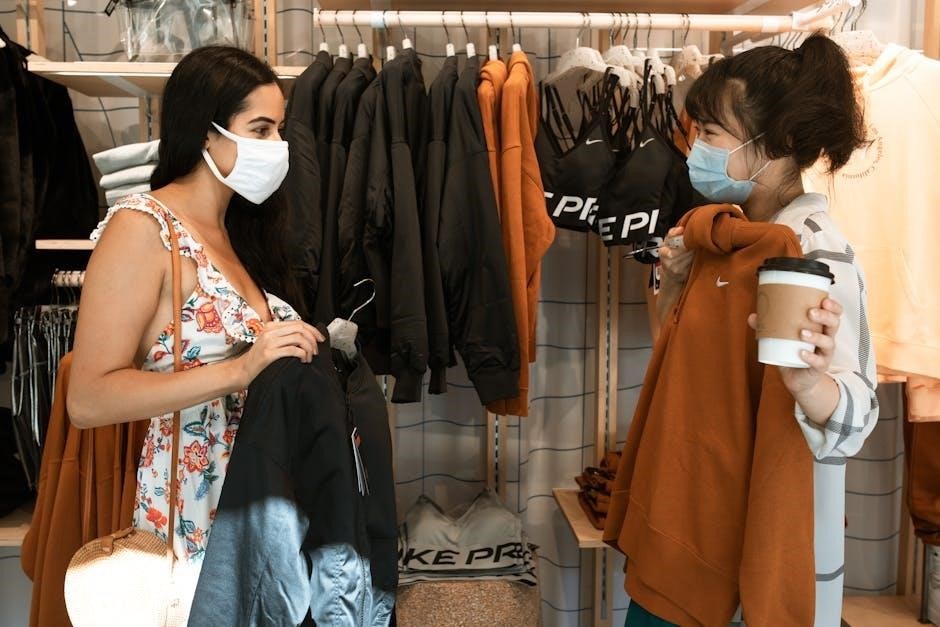Proper CPAP mask fitting is crucial for effective therapy, comfort, and preventing leaks. This guide covers key factors, including facial structure, breathing style, and mask compatibility, ensuring a seamless experience.
1.1 Importance of Proper Mask Fit
A proper CPAP mask fit is essential for effective therapy and comfort. It ensures a secure seal, preventing air leaks that can disrupt treatment and reduce the quality of sleep. A well-fitting mask also minimizes skin irritation and discomfort, making long-term use more manageable.
Poorly fitting masks can lead to inconsistent air pressure, reducing the effectiveness of CPAP therapy. They may also cause noise, disturbing both the user and their partner. Additionally, leaks can dry out the nasal passages or eyes, leading to further discomfort.
By achieving the right fit, users can enjoy uninterrupted therapy, improved sleep quality, and better overall health outcomes. Proper fit also enhances adherence to CPAP treatment, ensuring consistent benefits for managing sleep apnea.
1.2 Common Challenges with Mask Fitting
One of the most common challenges with CPAP mask fitting is achieving a proper seal without causing discomfort. Leaks are a frequent issue, often due to improper sizing or movement during sleep. Additionally, some users experience claustrophobia or difficulty breathing with certain mask types. Facial hair, oily skin, or irregular facial structures can also compromise the seal. Sleeping position further complicates fitting, as side or stomach sleepers may require different mask styles. Lastly, headgear adjustments can be tricky, as over-tightening leads to discomfort, while loose straps result in leaks. Addressing these challenges requires careful selection, proper sizing, and adjustments to ensure a balance between comfort and effectiveness.

Types of CPAP Masks
CPAP masks come in three main types: nasal, nasal pillow, and full-face. Each design caters to different needs, ensuring comfort and effectiveness for various sleeping styles and preferences.
2.1 Nasal Masks
Nasal masks are a popular choice, covering only the nose and offering a lightweight, unobtrusive design. They are ideal for back sleepers and those who prefer minimal facial contact. These masks work best for individuals who breathe primarily through their nose, ensuring airflow delivery without leaks. Proper sizing is essential to maintain comfort and effectiveness. Nasal masks are often recommended for users with higher prescription pressures, as they provide a reliable seal. Additionally, they are easy to adjust and clean, making them a practical option for many CPAP users.
2.2 Nasal Pillow Masks
Nasal pillow masks are a streamlined option, with small cushions resting at the nostrils. They are ideal for side sleepers and those who feel claustrophobic with larger masks. These masks allow for a wide field of vision, making them perfect for reading or watching TV before sleep. Nasal pillows are lightweight and less likely to cause skin irritation or red marks. They are also a great choice for individuals with beards or mustaches, as they don’t require a tight seal around the mouth. However, they may not be suitable for mouth breathers or those with nasal congestion. Proper fitting ensures minimal leaks and optimal comfort, making nasal pillow masks a preferred choice for many CPAP users seeking a more discreet solution.
2.3 Full-Face Masks
Full-face masks cover both the nose and mouth, providing a secure seal for mouth breathers or those with nasal congestion. They are ideal for back sleepers, as they maintain pressure distribution evenly. Made from soft, flexible materials, these masks are designed to minimize skin irritation and discomfort. The headgear is adjustable, ensuring a snug fit without over-tightening. Full-face masks are often recommended for individuals who require higher CPAP pressure settings. However, they may feel bulky for some users. Proper sizing is essential to avoid leaks and ensure comfort. Sizing guides can help determine the best fit. Additionally, some models feature magnetic headgear clips, which should be avoided by those with certain medical implants. Overall, full-face masks offer a reliable solution for users needing comprehensive coverage and a stable seal during sleep.

Choosing the Right Mask Type
Choosing the right CPAP mask type involves considering sleeping position, facial structure, and breathing style to ensure comfort and effectiveness. Options include nasal, nasal pillow, or full-face masks, each catering to different needs for a proper fit.
3.1 Considerations for Sleeping Position
Your sleeping position plays a significant role in CPAP mask selection. Side sleepers may prefer masks with a stable seal to prevent leaks, while back sleepers can opt for lighter designs. Stomach sleepers often benefit from minimal-contact masks to avoid pressure points. Additionally, if you change positions frequently, an adjustable or full-face mask might provide better stability and comfort. Ensuring the mask accommodates your movement without compromising the seal is essential for uninterrupted therapy. Proper fitting and headgear adjustments can help maintain comfort and effectiveness, regardless of your preferred sleeping position.
3.2 Importance of Facial Structure
Facial structure significantly impacts CPAP mask fit and comfort. Features such as nose shape, bridge height, and cheekbone prominence influence mask compatibility. For instance, a high-bridge nose may require a specific nasal mask design, while flatter facial contours might benefit from a different style. Facial hair, such as beards, can also interfere with the mask seal, potentially leading to leaks. Understanding your facial dimensions helps in selecting a mask that provides optimal comfort and effectiveness. Sizing guides and professional fittings can further ensure a proper match. Additionally, masks designed for various facial structures, such as petite or broad faces, cater to individual needs. Considering these factors ensures a secure fit, enhancing therapy adherence and overall sleep quality.
3.3 Breathing Style and Mask Compatibility
Breathing style plays a critical role in selecting the right CPAP mask. Mouth breathers typically require full-face masks to deliver air effectively, while nasal breathers may find nasal or nasal pillow masks more comfortable. Mixed breathers, who switch between mouth and nose during sleep, often benefit from full-face masks to ensure consistent airflow. Additionally, breathing patterns during sleep, such as rapid breathing or deep inhalations, can affect mask fit and seal. Masks with adjustable headgear and cushion designs help accommodate different breathing styles. It’s essential to assess how you breathe during sleep to choose a mask that aligns with your needs, preventing leaks and ensuring therapy effectiveness. This compatibility enhances comfort and promotes better adherence to CPAP therapy.

The Fitting Process
The CPAP fitting process involves measuring, sizing, and adjusting headgear to ensure a proper seal and comfort, crucial for effective therapy and a restful night’s sleep.
4.1 Measuring and Sizing Your Mask
Accurate measurement and sizing are essential for a proper CPAP mask fit. Use sizing guides or templates provided by manufacturers to determine the correct size for your face. Print and cut out the template, then place it against your face to ensure a precise fit. Measure across the bridge of your nose and under the nostrils for nasal masks, or around the mouth and chin for full-face masks. Proper sizing ensures a comfortable seal without leaks. Consult a healthcare professional if unsure, as improper sizing can lead to discomfort or ineffective therapy. Avoid over-tightening, as this can cause skin irritation or pressure marks. Regularly check and adjust the fit to accommodate any changes in weight or facial structure. A well-fitted mask enhances therapy effectiveness and improves sleep quality.
4.2 Adjusting Headgear and Testing Fit
‘. The topic is ‘cpap mask fitting guide’, and they’ve provided some specific instructions on how to approach this.
Looking at the history, I see that the user provided some internet findings. Those include tips on proper mask fitting, avoiding over-tightening, using sizing guides, and the importance of facial structure and sleeping position. I need to make sure I incorporate that information without veering into other areas.
I remember the example response the user gave for this subheading. It talks about adjusting the headgear for a snug fit without over-tightening, using the X-y strap method, lying down to test pressure points, and using a mirror to check the seal. Also, it mentions testing the fit while the machine is on and adjusting as needed.
So, I need to come up with something new but similar in content. I should mention the importance of the headgear, how to adjust it properly, methods to ensure a good fit, and how to test it. I should also touch on common mistakes like over-tightening and how to avoid them.
I should also ensure that the language is clear and helpful, avoiding any technical jargon that might confuse the reader. The tone should be informative and reassuring, letting the user know that with proper adjustment, their CPAP therapy can be more effective and comfortable.
Let me think about the key points to include:
Adjusting headgear properly to avoid leaks and discomfort.
The method of adjusting straps in an X or Y pattern.
Testing the fit by lying down and checking for pressure points.
Using a mirror to inspect the seal.
Testing with the CPAP machine on to ensure no leaks.
Making adjustments as needed and rechecking the fit.
Avoiding over-tightening to prevent skin irritation.
The benefits of proper adjustment for therapy effectiveness.
I need to weave these points into a coherent paragraph without exceeding the word limit. I’ll also make sure to use the information from the provided internet findings, like the importance of proper sizing and the impact of facial structure.
I should start by introducing the importance of headgear adjustment, then explain the steps, and finally discuss the outcomes. I’ll also mention common mistakes to avoid, like over-tightening, to provide a comprehensive guide.
Let me try drafting this:
“Adjusting the headgear is crucial for a comfortable and effective CPAP mask fit. Start by placing the mask on your face and fastening the headgear straps in an X or Y pattern to ensure even pressure. Tighten the straps gradually, ensuring the mask seals without air leaks. Lie down in your usual sleeping position to test the fit, checking for any pressure points or discomfort. Use a mirror to inspect the seal around the edges. Turn on the CPAP machine to test the fit with airflow, making adjustments as necessary. Avoid over-tightening, as this can cause skin irritation or discomfort. Properly adjusted headgear enhances the effectiveness of CPAP therapy, ensuring a restful night’s sleep.”
Now, I need to count the words to make sure it’s exactly 138. Let me count:
Adjusting
the
headgear
is
crucial
for
a
comfortable
and
effective
CPAP
mask
fit.
Start
by
placing
the
mask
on
your
face
and
fastening
the
headgear
straps
in
an
X
or
Y
pattern
to
ensure
even
pressure.
Tighten
the
straps
gradually,
ensuring
the
mask
seals
without
air
leaks.
Lie
down
in
your
usual
sleeping
position
to
test
the
fit,
checking
for

any
pressure
points
or
discomfort.
Use
a
mirror
to
inspect
the
seal
around
the
edges.
Turn
on
the
CPAP
machine
to
test
the
fit
with
airflow,
making
adjustments
as
necessary.
Avoid
over-tightening,
as
this
can
cause
skin
irritation
or
100. discomfort.
101. Properly
102. adjusted
103. headgear
104. enhances
105. the
106. effectiveness
107. of
108. CPAP
109. therapy,
110. ensuring
111. a
112. restful
113. night’s
114. sleep.
Wow, that’s . I need to add 24 more words. Let me expand on some points:
“Adjusting the headgear is crucial for a comfortable and effective CPAP mask fit. Start by placing the mask on your face and fastening the headgear straps in an X or Y pattern to ensure even pressure distribution. Tighten the straps gradually, ensuring the mask seals without air leaks; Lie down in your usual sleeping position to test the fit, checking for any pressure points or discomfort. Use a mirror to inspect the seal around the edges, ensuring no gaps. Turn on the CPAP machine to test the fit with airflow, making adjustments as necessary. Avoid over-tightening, as this can cause skin irritation or discomfort. Properly adjusted headgear enhances the effectiveness of CPAP therapy, ensuring a restful night’s sleep and improving overall treatment outcomes.”
Now, let me recount:
Adjusting
the
headgear
is
crucial
for
a
comfortable
and
effective
CPAP
mask
fit.
Start
by
placing
the
mask
on
your
face
and
fastening
the
headgear
straps
in
an
X
or
Y
pattern
to
ensure
even
pressure
distribution.
Tighten
the
straps
gradually,
ensuring
the
mask
seals
without
air
leaks.
Lie
down
in
your
usual
sleeping
position
to
test
the
fit,
checking
for
any
pressure
points
or
discomfort.
Use
a
mirror
to
inspect
the
seal
around
the
edges,
ensuring
no
gaps.
Turn
on
the
CPAP
machine
to
test
the
fit
with
airflow,
making
adjustments
as
necessary.
Avoid
over-tightening,
as
this
can
100. cause
101. skin
102. irritation
103. or
104. discomfort.
105. Properly
106. adjusted
107. headgear
108. enhances
109. the
110. effectiveness
111. of
112. CPAP
113. therapy,
114. ensuring
115. a
116. restful
117. night’s
118. sleep
119. and
120. improving
121. overall
122. treatment
123. outcomes.
That’s . I still need
5.2 Using Comfort Accessories and Cleaning
Tips for a Comfortable Fit
Ensure a comfortable fit by avoiding over-tightening, using comfort accessories like pads, and cleaning regularly. Proper care and maintenance enhance comfort and mask longevity, improving therapy effectiveness.




Leave a Reply
You must be logged in to post a comment.